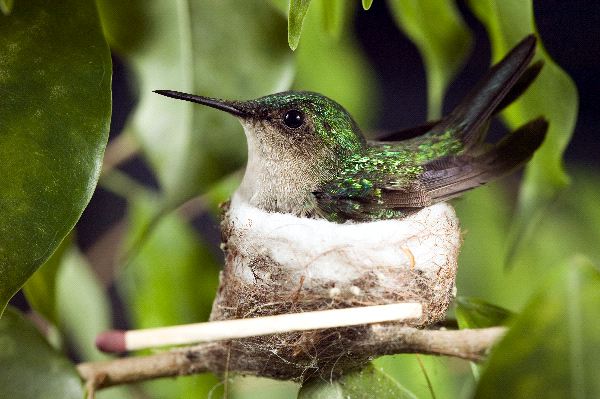On a recent walk around the lake with my husband Ralph and a couple of friends, I spotted what I suspected to be a hummingbird nest attached to the thin branches of a grapevine entwined in a wax myrtle tree.
 |
| My discovery...but what is it? |
Shaped like a miniature urn, the inch-and-a-half long structure has a small opening of about a half-inch diameter at its top. The nest was hanging from the slimmest of twigs by a weaving of threads — silky, golden filigree — that look as though they came from the web of a banana spider, also known as a golden silk orb weaver (Nephila clavipes). Affixed to the structure’s tan surface by more glimmering fibers were five shriveled brown grape leaves. Like so many insect and bird nests, it was an architectural gem — a sturdy and organic formation, beautiful in its functional simplicity.
.JPG) |
| Hummingbirds often incorporate the golden silk from a Nephila clavipes web to add strength to their nests |
As soon as I spotted the structure, my immediate reaction was to take it home with me. I have a collection in my porch of abandoned bird nests I’ve found over the years but until then, a nest made by a hummingbird was not among them.
It was easy to snap the thin twigs with my fingers and take it back to our house. I was pleased with myself for finding it and excited about the opportunity to examine it more closely in the comfort of home with the computer close by for research help.
But that’s when my good feelings began to fade. The more I learned about hummingbird nesting habits, the more I realized the mistake I might have made.
As it turns out, some species of hummingbirds repair and reuse the same nest year after year. By removing the well-camouflaged structure from its vine-entwined location, I may inadvertently have prevented a hummingbird from raising young in that spot again and hampered the nest-building efforts of a female hummer.
It takes a long time for a mother hummingbird to construct a secure spot to incubate eggs. She starts by selecting a location that is sheltered from predators and the elements and not too far from water and food sources. She then spends about four hours every day for a week — approximately 34 trips per hour — gathering materials such as lichen, silk from spider webs, leaf hairs, dryer lint and cotton fluff to mold with her body into the proper shape to house the eggs she will soon lay. It’s a substantial effort, and I hate thinking my eagerness to possess the result of her hard work thwarted a chance for her to reuse it.
 |
| Hummingbird gathering cattail fluff for its nest Photo credit: www.learner.org |
Then again, the structure I found might not be a hummingbird nest at all. Worldwide, there are 338 species with 16 found in the United States and three inhabiting Florida. Of those three, Ruby-throated hummers are the most common and their cup-shaped nest looks different from the urn-shaped structure I found. Nor does it resemble the nest of Florida’s two other species, the black-chinned or rufous hummingbird, either.
 |
| Cup-shaped Ruby-throated hummingbird nest Photo credit: www.hummingworlds.com |
So what exactly did I find on my walk around the lake? Was it a hummingbird nest or something else? When we saw it, my friend Pam’s first reaction was that it belonged to a wasp, and Pam might be right. However, none of my research has yielded any wasp, caterpillar or other insect that builds a cocoon or nest like the one we found.
Despite not knowing exactly what it is, I admire its beauty. It now hangs in my office to the left of my computer where I can see it every day. I may have mistakenly made life more difficult for a hummingbird mama but in the process, I also gave myself a reminder: Nature is full of unexpected treasures. It is as wondrous as it is mysterious, as marvelous in its minutia as it is in its magnitude.
This experience taught me something, too. Next time, I’ll take a picture, leaving my discovery in place. While nature may be full of marvels, I don’t need to ‘own’ each one.

Really good article. I've wanted to "own" a hummingbird nest for as long as I can remember. We've had a return visitor since Hurricane Charley. Andree
ReplyDeleteHi Andree - Every visit from a hummer is a treat. How fortunate to have a hummingbird that returns every year.
Delete